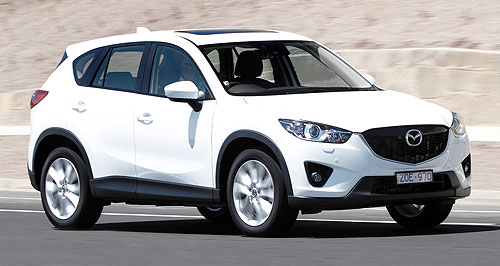Make / Model Search
News - MazdaMazda global inspired by Australian successGrowth area: Mazda’s CX5 crossover has proven to be a hit for the brand both in Australia and its home market of Japan. Customer service-focused strategy to lead Mazda to sustainable global growth25 Aug 2014 MAZDA Australia’s successful strategy of focusing on customer service and loyalty to win sales will be replicated in other global markets as the brand seeks a sustainable expansion beyond its home market. The Japanese car-maker has become the top-selling full-line importer in Australia on the back of a well-received product portfolio, which includes the second best-selling car in the country, the Mazda3, as well as the popular CX-5 crossover and strong selling Mazda2 light hatch range. The focus on customer satisfaction has seen it top the JD Power customer service index in 2013 ahead of rivals including Toyota, Honda, Subaru and Nissan. Speaking with GoAuto at the Mazda2 launch in Japan last week, Mazda general manager of global sales and marketing Yasuhiro Aoyama said the company’s success in Australia started in the late 1980s and continued through the ’90s, which he admits was a time when it was offering less-than-stellar product. The biggest change for the brand, according to Aoyama-San, was the launch of the first-generation Mazda6 mid-sizer in 2002 which significantly lifted the quality of the company’s products. “I personally believe the fundamental success factor of Mazda Australia belongs to how to make the best relationship with the customers,” he said. “Therefore the period, not to just sell the new vehicle only, just after selling the vehicle, to have the best relationship with customers, that is the fundamental strength of Mazda Australia. “And then we have strong products and we had a dramatic improvement in the business in Australia. The fundamental part is the relationship with the customer. It is very easy to say so, but it is very difficult to achieve.” Aoyama-San said the company was working hard to build the brand globally and would leverage its reputation for service and quality as part of its push for sustainable growth in various markets. One key to that was via word-of-mouth promotion of the brand from its existing customer base, Aoyama-San said. “I think that even much more important than the new car sales, we need to get the customer satisfaction and customer engagement to have them become the brand loyalists. That should be the focus,” he said. With the success of Mazda Australia – which sold 103,144 units last year to be the third best-selling brand behind Toyota and Holden – Aoyama-San said the company would roll out similar customer-focussed sales strategies to other markets shortly. “Recently we would like to achieve the success of Australia in other regions. So customer care, customer engagement or loyalty should be the centre of our sales and marketing strategy. “In the past we tend to put the emphasis on the new-car sales deal. Just after selling the vehicle, was the centre of focus for marketing strategy. “But from now on, leveraging Mazda Australia's work, we put more focus on after-sales work, before loyalists, before repurchasing type of activities. “So it will be deployed to the other countries, including the UK and some countries that we have very little presence, and we can change our direction.” Last year, Mazda sold 1.33 million units globally and recorded a Japanese fiscal year profit of ¥135.7 billion ($A1.41b), and while the company has detailed plans to boost sales this year by 6.7 per cent to 1.42 million, Aoyama-San said the company would not push for rapid growth. “In the Mazda2 class, we get around 30-40 per cent market share (in Japan). But above the ¥2-3 million (segment) we have very little presence. “But after the introduction of CX-5 and Mazda6, we are currently getting a very large presence of market share – 13-14 per cent in the more than ¥2 million. “So rather than rapid … maybe the balance between revenue structure and volume growth will be much more important for Mazda to put more emphasis on building the brand side,” he said. “So we are currently not pursuing the rapid growth, unnecessary growth. Rather than that, we want more emphasis on how to improve net revenue side.” Without confirming the existence of the long-rumoured Mazda2-based sub-compact crossover, Aoyama-San said the highly profitable SUV segment meant an expansion of product in this area made sense. “It belongs to the future strategy, but how to make our average net revenue much higher than currently? And of course the Australian market has [a] similar problem. “SUVs have better revenue than the sedans and the hatchbacks, so it would be more rational to put the emphasis on the SUV side, crossover side.” A small crossover would become the entry-level SUV in Mazda’s range and sit below the top-selling CX-5 and the ageing CX-9 seven-seater.  Read more |
Click to shareMazda articlesResearch Mazda Motor industry news |












Facebook Twitter Instagram